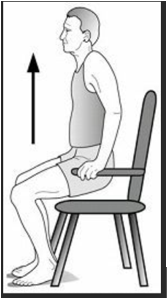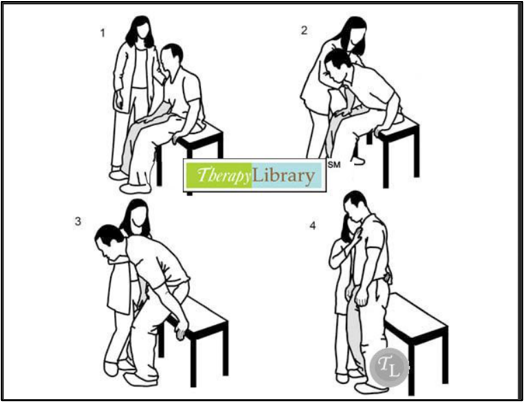| TOPIC | Manual Handling: Transfer Sit to Stand | ||
| Domain | Governance | TYPE | Procedure |
Manual Handling: Transfer Sit to Stand Work Instruction
1.1 Independent Sit to Stand – Providing guidance to a consumer
Instruct the consumer to:
- Place their hands on the arm rests
- Scoot their hips to the edge of the chair.
- Bring their feet flat on the floor under their body.
- From their trunk and hips, lean forward in preparation for standing i.e., “nose is over your toes.”
- Push down with their feet and legs to lift their hips off the chair.
- Extend their knees and hips while continuing to hold the arm rests.
- When ready, grab their walker with one hand and then the other
- Stand up tall stretch their hips, knees and back.

Source: Eight Steps to Improving Sit-to-Stand Transfers (healthfully.com)
1.2 Assisted Sit to Stand Work Instruction (Minimal Assistance)
Aid the consumer by:
- Helping the consumer slide to the edge of the surface (e.g., bed/ chair)
- Positioning their feet on the floor with a wide base of support.
- Standing on the consumer’s affected or weaker side.
- Having the consumer push with their strong hand and supporting their other hand on the front wheeled walker or another device. Alternatively, having the consumer push with both hands from their armrests or surface.
- Stabilising the consumers involved knee with your own knee if hemiparetic.
- Supporting the consumer at the waist or gait belt as they come into a stand.
- Instructing the consumer to stand up straight and/or “squeeze their bottom together.”
1.3 Sit to Stand Lifts (Moderate to Maximum Assistance)
Sit-to-stand lifts are prescribed for consumers with reduced mobility. The correct procedures must be followed when lifting a consumer with one of these devices.
Refer to the User Manual for the Lift being used. Where the manual is not available in the consumers home, search for the user manual on the internet by the Lift BRAND and MODEL number.
Things to remember when using a Lift
Place the Device Correctly
- Place the device in the correct position and secure the brakes to prevent accidents.
- Place the sit-to-stand lift close enough so the consumer they can grab the metal bars easily.
Note: You will need to connect the sling to the device before lifting.
Secure the Sling to the Consumer
- Secure the device’s sling around the consumer. Ensure it is tight but not uncomfortable. The sling prevents accidents and falls.
- Most models will come with a stand assist sling and a transfer stand assist sling. The difference between the two is that the second one offers more support for the legs and better weight capacity.
Lift the Consumer
- Once the sling is secured the sling, help the consumer stand up carefully. During lifting, ensure that the consumer grabs the grip and uses their strength to stand up.
Note: The consumer must keep both feet on the device’s footplate.
- Once the consumer is in the correct position, use lifting mechanism to rotate the device, allowing the consumer to stand up without risk of injury.
Remove the Device
- Once the consumer is standing, put the lift away to prevent accidents and falls.
- Release the brakes, place the device in the corner of the room, and secure the brakes again.
Source: Senior Mobility Complete Guide to Using a sit to Stand Lift
Document History
Reviewed by: Clinical and Risk Specialist
Authorised by: CEO
Date Adopted:
Next Review Due:
Version Control
| Version | Date | Change |
| 1 | 10/4/22 | New |
